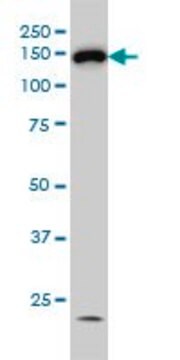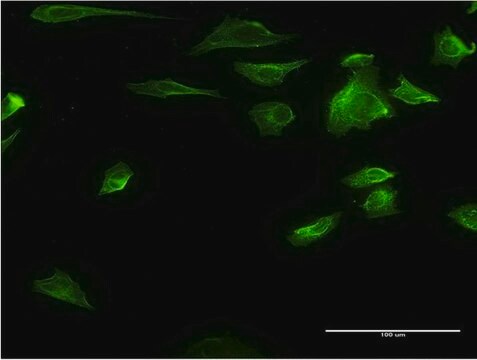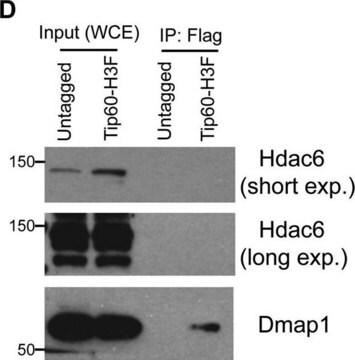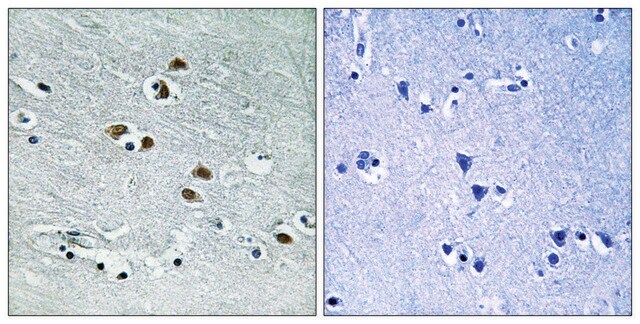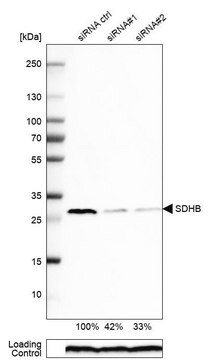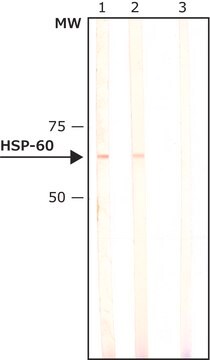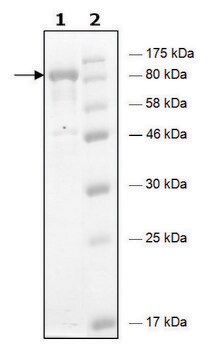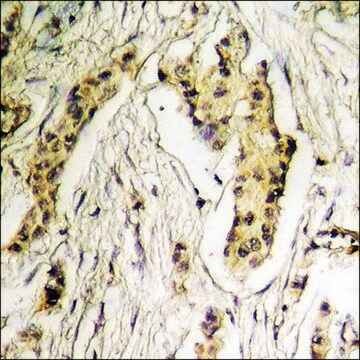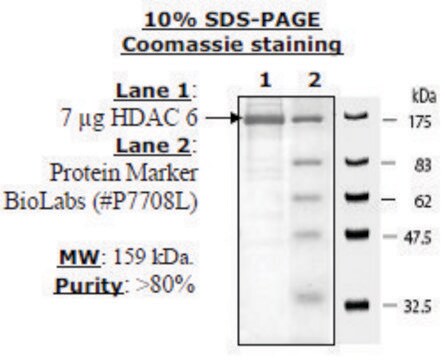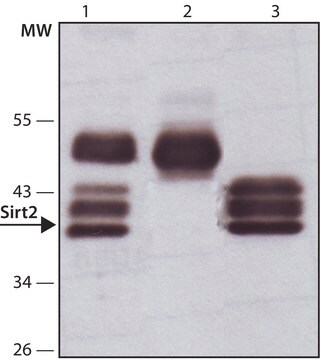推薦產品
生物源
rabbit
品質等級
共軛
unconjugated
抗體表格
IgG fraction of antiserum
抗體產品種類
primary antibodies
無性繁殖
polyclonal
形狀
buffered aqueous solution
分子量
antigen ~134 kDa
物種活性
human, mouse
技術
immunoprecipitation (IP): 5-10 μg using RIPA extract of 500 μg of 293T cells expressing recombinant mouse HDAC6.
microarray: suitable
western blot: 1:1,000 using 293T cells expressing recombinant mouse HDAC6 in a chemiluminescent detection system.
UniProt登錄號
運輸包裝
dry ice
儲存溫度
−20°C
目標翻譯後修改
unmodified
基因資訊
human ... HDAC6(10013)
mouse ... Hdac6(15185)
一般說明
Anti-Histone Deacetylase 6 (HDAC6), is produced in rabbit using a synthetic peptide corresponding to amino acid residues 1199-1213 of human HDAC6. Mammalian HDACs can be divided into three classes according to sequence homology. Class I consists of the yeast Rpd3-like proteins HDAC1, HDAC2, HDAC3 and HDAC8. Class II consists of the yeast Hda1-like proteins HDAC4, HDAC5, HDAC6, HDAC7, HDAC9 and HDAC10. Class III consists of the yeast Sir2-like proteins. Class I HDACs are ubiquitously expressed, most class II HDACs are tissue-specific. Class II HDACs are larger than those of class I and their catalytic domain is located in the carboxy-terminal half of the protein. HDAC6 is a unique deacetylase among class II members in that it contains a duplicate of the catalytic domain in its NH2 terminus as well. The deacetylase activity of class II HDACs is regulated by subcellular localization. Endogenous HDAC6 is predominantly cytoplasmic where it associates with microtubules and functions as an a-tubulin deacetylase. HDAC6 contains a conserved zinc finger motif that is probably involved in the regulation of ubiquitination. The gene HDAC6 is mapped to human chromosome Xp11.23.
特異性
Anti-Histone Deacetylase 6 (HDAC6) recognizes human and mouse HDAC6 (~134 kDa). Detection of HDAC6 by immunoblotting is specifically inhibited with the immunizing peptide. Additional nonspecific bands of approx. 50 kDa may be detected in various extract preparations.
免疫原
synthetic peptide corresponding to amino acid residues 1199-1213 of human HDAC6. The corresponding sequence in mouse differs by one amino acid.
應用
Anti-Histone Deacetylase 6 (HDAC6) recognizes human and mouse HDAC6 (~134 kDa). Applications include immunoblotting, immunoprecipitation, immunocytochemistry and immunohistochemistry.
Applications in which this antibody has been used successfully, and the associated peer-reviewed papers, are given below.
Immunohistochemistry (1 paper)
Western Blotting (1 paper)
Immunohistochemistry (1 paper)
Western Blotting (1 paper)
生化/生理作用
Histone Deacetylase 6 (HDAC6) is an enzyme responsible for deacetylation of histones. HDAC6 is a part of transcriptional corepressor complexes. Overexpression or destruction of HDAC6 may lead to Alzheimer, Parkinson and cardiovascular diseases. Overexpression of HDAC6 is implicated in various cancers like malignant melanoma, lung and bladder cancer. It promotes tumorigenesis, cell migration and invasion. HDAC6 also regulates the expression of critical immune system molecules, targets of chemotherapy like programmed death receptor-1 (PD-1). Mutations in HDAC6 causes X-linked chondrodysplasia.
外觀
0.01M 磷酸缓冲盐溶液,pH 7.4,含 15mM 叠氮化钠。
免責聲明
Unless otherwise stated in our catalog or other company documentation accompanying the product(s), our products are intended for research use only and are not to be used for any other purpose, which includes but is not limited to, unauthorized commercial uses, in vitro diagnostic uses, ex vivo or in vivo therapeutic uses or any type of consumption or application to humans or animals.
未找到適合的產品?
試用我們的產品選擇工具.
客戶也查看了
The human histone deacetylase family
Gray SG and Ekstrom TJ
Experimental Cell Research, 262(2), 75-83 (2001)
Histone deacetylase 6 in cancer
Li T, et al.
Journal of Hematology & Oncology, 11(1), 111-111 (2018)
The class I-specific HDAC inhibitor MS-275 modulates the differentiation potential of mouse embryonic stem cells
Franci G, et al.
Biology Open, 2(10), 1070-1077 (2013)
Activation of autophagy in mesenchymal stem cells provides tumor stromal support
Sanchez CG, et al.
Carcinogenesis, 32(7), 964-972 (2011)
Cecilia G Sanchez et al.
Carcinogenesis, 32(7), 964-972 (2011-02-15)
Recent studies have implicated multipotential mesenchymal stem cells (MSCs) as an aid to breast cancer cell proliferation and metastasis, partly as a result of the MSCs secretome. As the tumor gets beyond 2 mm in diameter, the stromal cells could
我們的科學家團隊在所有研究領域都有豐富的經驗,包括生命科學、材料科學、化學合成、色譜、分析等.
聯絡技術服務